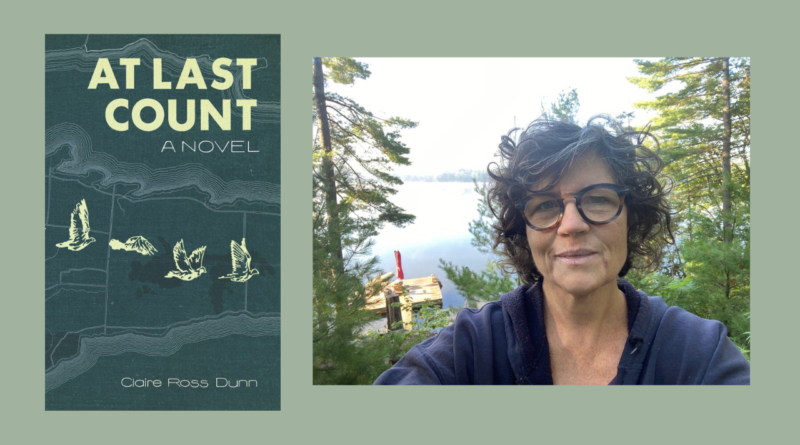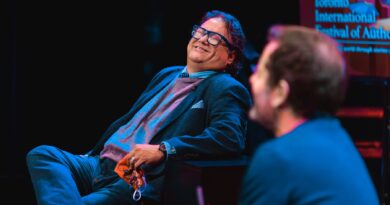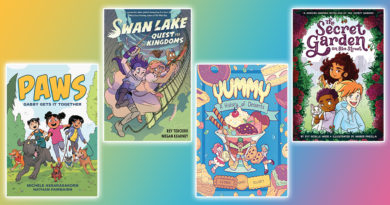Claire Ross Dunn’s 15-Year journey to write “At Last Count”
For 27 years, Claire Ross Dunn has been a film and TV writer for shows like Little Mosque on the Prairie, Wingin’ It, and Degrassi: The Next Generation. For the stage, she co-wrote the multidisciplinary solo show The Knitting Pilgrim with her husband, Kirk Dunn. In 2022, she added “published author” to her byline with the release of her first novel, At Last Count (Invisible Publishing, 2022). In a reflection of Dunn’s writing process, the book is a succession of chapters ending in cliff-hanging hooks that make it impossible to put down: “It was an incredible experience to be a newbie author, while being an experienced writer,” says Dunn. “I didn’t know the process; I kept asking, ‘What happens next?’”

At Last Count is a compelling narrative that intertwines the themes of mental health, personal growth, and the power of confronting one’s past. Protagonist Paisley Ratchford struggles with obsessive-compulsive disorder (OCD), a condition that pushes her to count and check things in sets of eight. The compulsion dominates her life, but she has established a semblance of order within her world . . . until the demolition of her Toronto apartment building forces Paisley to seek a new place to live. This process leads her back to her childhood home on Amherst Island. Here, she comes face to face with her past, including her mother’s mental illness, her father’s misfortunes, and Garnet Mulligan, former tormentor of her youthful self.
The novel is presented through dual timelines, offering insights into Paisley’s difficult childhood and her journey towards healing and understanding. Dunn’s portrayal of OCD is educational and sensitively handled, providing a window into the complexities of living with this condition. And the unique bird life of Amherst Island plays a significant symbolic role in the story, reflecting Paisley’s journey and the themes of freedom and resilience.
The story of how At Last Count came to be is a deeply personal and epic tale in itself. It began in 2005, when Dunn started a writing circle as an antidote to the stress of writing for television – and as a way to enjoy the pure pleasure of writing. The group challenged each other to submit funding requests to bodies like the Toronto Arts Council Literature and the Ontario Arts Council. Dunn applied to – and by 2006, had won funding from – both of these organizations. Now, she realized, she had to write a novel. “It was terrifying,” says Dunn. Even though she had been working for years as a television writer, “it felt like writing scripts was sprinting, and writing a novel was like running a marathon”.
So Dunn elected to use some of her funding to register at the Humber School for Writers. During her first pass there, she developed an initial draft of the book. She then re-enrolled to develop the second draft. When she then felt that she still needed another pass, she decided to hire freelance editor Nathan Whitlock. It was Whitlock who proposed the idea of restructuring the book into a “now-and-then” structure. “I was pretty grumpy about that,” says Dunn. “It meant going through everything and intercutting the lead, Paisley, as a thirteen-year-old, and then as a fourty-year-old . . .. It took me a week of mulling it over, but then I did that, and rewrote the whole book.”
This occurred in 2012, and once the rewrite was completed, Dunn sent the book to three publishers. They all liked the book . . . but each said it was not right for them. “I found the process of submitting to publishers really stressful, which surprised me,” says Dunn. “I thought to myself, I do a lot of pitching and television, so why am I so stressed? But it was in that analysis that I realized, Oh my God – I wrote this book about my own experience as a child with OCD. I thought I had been writing a completely fictional story!”.
With this insight, gained from re-reading the book, Dunn realized that her anxiety stemmed from being terrified that she would be found out. Her experience as a child with OCD, who felt alone and had no support, was at that point a secret known only by her husband and a few of her closest friends. Not even her parents knew this. All of this gave her pause, making her wonder, “What if I never get hired again, because people think I’m weird?”. So she put the book in a drawer, where it would sit for more than 8 years.

Telling herself that the novel had been nothing more than a passing fancy, Dunn continued to work as a writer in television . . . until COVID-19 forced her hand. In 2020, the pandemic shut down all film and TV production worldwide. Dunn recalls the first days of lockdown being surreal: “I remember seeing a coyote run down our street because it was absolutely deserted.” Denied her usual outlets, Dunn asked herself, “What should I be doing with this moment?”. The energy that she found in lockdown was rooted in risk-taking and creative liberty – because there might not be a lot of time left. At this critical moment, the Canada Council offered a special grant to support the arts. Individuals could apply for five thousand dollars to pivot any project to digital.
Dunn thought carefully about her projects, and what she could do with that amount of money. Producing a TV show would be far too expensive… but maybe she could pull her now-dusty novel out of the drawer, and produce an audiobook version. Dunn knew actors who could help to read it, and all the work could happen remotely. And the passage of time had given her a new perspective. When she cracked it open, “I liked what I read, which was a lovely feeling.” Dunn was now a lot less fearful of others’ reactions, so she decided to apply to the Canada Council. But a quiet voice insisted, “If I produce this audiobook, I still won’t let anyone know that Paisley is me.”
In order to prepare her application for the Canada Council, Dunn interviewed editors to make sure the book was ready for actors to record. After four interviews, she hired Alex Shultz to be the book’s final editor. On top of his editorial skills, Shultz disclosed two unique, almost spooky qualifications, which won him the job: 1) He lived in Prince Edward County and could see Amherst Island from his back porch. 2) He was a junior card-carrying ornithologist when he was 13 and living in Ireland. The stars had aligned. Not only had Amherst Island been settled by Irish farmers, but it also has a bird sanctuary. And in At Last Count, Paisley is a bird lover whose quest for a rare bird is a major through-line of the book.
After hiring Alex, to her great surprise, Dunn was not awarded the Canada Council grant. She had no income, but had already fallen in love with the idea of Shultz editing the book. Haunted by the thought that At Last Count might be her last creative output, Dunn hired Shultz anyways, hoping that she would sell the audiobook, or her next gig would pay off this debt.
Halfway through reading the book, Shultz called Dunn to say that he loved the story, and wanted to submit it personally to a publisher. Before he did so, he asked Dunn an unexpectedly direct question about the OCD. “Is that you?” he asked about Paisley. “Do you have experience with that?” Dunn’s knees shook as she made the confession. Shultz was the first person she had ever told outside of her inner circle. Then, when she spoke to the publishers, they posed the same question. “So much about the writer’s voice is about ‘no voice appropriation’ and ‘having credibility’,” says Dunn. And this has made “The book . . . such a gift for me, in terms of being able to talk about a very hard thing, and getting a secret out from the shadows and into the light . . .. It’s been a really amazing process.”
Before long, Dunn secured her publishing contract with Invisible Publishing. Leigh Nash, the publisher at Invisible Publishing at the time, loved the now-and-then structure, and challenged Dunn to lean even deeper into it, intercutting more often between timelines, which would help with the momentum of the book. “I can’t say enough good things about them,” says Dunn about Invisible Publishing. “They’re so writer-friendly, kind, and considerate. They knew OCD was a big part of the book, and they were very sensitive around asking questions and keeping the conversation going.”

When asked about the editing process, she offers two insights. First, “it’s all about the drafts. Writing is always in the rewriting. The longer you’re a writer, the more you understand that you have to try the next draft”. Second, revising her work allows Dunn to get to know her material better and to build a deeper relationship with her note-givers. “It’s less about the note itself than what is behind a note,” says Dunn. “What are you trying to get at? What’s the goal? Because there might be another path to getting to the goal, or maybe the note is the right path.”
Finally, fifteen long years after the idea was born, At Last Count was published in June, 2022. Having undergone so many stages of writing, recessing, reconsideration and revision, the novel is a true testament to Dunn’s perseverance. Knowing when to infuse energy into her work, when to let it rest, and when and how to revive it has allowed At Last Count to be published at the perfect time.
Tender, often funny, and deeply present and evocative, Dunn’s story is a touchstone for our time, inviting the reader to reconnect with all of nature – the external world’s birds and trees, and the interior world of our heart and soul.
© Emilia Voudouris, SesayArts Magazine, 2024
About The Author
Emilia Voudouris
Emilia Voudouris is a Mexican storyteller who believes in magic. From a young age, she has gravitated to cinematography and writing as instruments for connecting with the heart of the stories she explores.




